Bph pathophysiology - Study guides, Class notes & Summaries
Looking for the best study guides, study notes and summaries about Bph pathophysiology? On this page you'll find 590 study documents about Bph pathophysiology.
Page 3 out of 590 results
Sort by
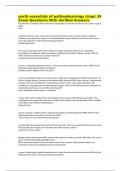
-
porth essentials of pathophysiology chapt 39 Exam Questions With Verified Answers
- Exam (elaborations) • 9 pages • 2024
-
- $10.59
- + learn more
porth essentials of pathophysiology chapt 39 Exam Questions With Verified Answers Circumcision is avoided in infants who have hypospadias so that the foreskin can be used for surgical repair. True A 60-year-old man comes to the clinic and has been found to have a history of type 2 diabetes mellitus and cardiovascular disease. The manifestations of these diseases will warrant the nurse to assess the patient for which of the following problems? Erectile dysfunction The nurse is asse...
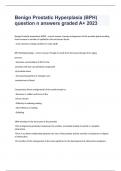
-
Benign Prostatic Hyperplasia (BPH) question and answers already passed
- Exam (elaborations) • 9 pages • 2024
- Available in package deal
-
- $13.49
- + learn more
Benign Prostatic Hyperplasia (BPH) question and answers already passed Benign Prostatic Hyperplasia (BPH) - correct answer a benign enlargement of the prostate gland resulting from increase in number of epithelial cells and stream tissue. -most common urologic problem in male adults BPH Pathophysiology - correct answer Though to result from hormonal changes from aging process: -Excessive accumulation of DHT in the prostate cells that can stimulate overgrowth of prostate tissue ...
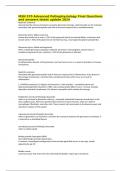
-
MSN 570 Advanced Pathophysiology Final Questions and answers latest update 2024
- Exam (elaborations) • 12 pages • 2024
-
- $10.59
- + learn more
MSN 570 Advanced Pathophysiology Final Questions and answers latest update 2024 Nephrotic syndrome characterized by massive proteinuria caused by glomerular damage. corticosteroids are the mainstay; Associated with glomerulonephritis and with an immune response that is noninflammatory. Glomerular Injury: Diffuse and Focal Lesions that involve all or most (> 50%) of the glomeruli (plural) are termed diffuse, and lesions that involve some (< 50%) of the glomeruli are termed focal (e....
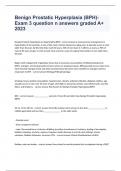
-
Benign Prostatic Hyperplasia (BPH)- Exam 3 Questions with complete solution 2024
- Exam (elaborations) • 9 pages • 2024
- Available in package deal
-
- $13.49
- + learn more
Benign Prostatic Hyperplasia (BPH)- Exam 3 Questions with complete solution 2024 Benign Prostatic Hyperplasia or Hypertrophy (BPH) - correct answer A noncancerous enlargement or hypertrophy of the prostate, is one of the most common diseases in aging men. It typically occurs in men older than 40 years. By the time they reach 60 years, 50% of men have it. It affects as many as 90% of men by 85 years of age. It is the second most common cause of surgical intervention in men older than 60 years. ...
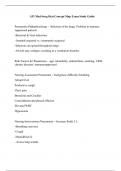
-
ATI Med-Surg Hesi Concept Map Exam Study Guide
- Exam (elaborations) • 41 pages • 2023
-
- $12.00
- + learn more
Pneumonia Pathophysiology - -Infection of the lungs. Problem in immunesuppressed patients. -Bacterial & Viral infections - hospital-acquired vs. community-acquired -Infection can spread throughout lungs. -Alveoli may collapse, resulting in a ventilation disorder. Risk Factors for Pneumonia - -age, immobility, malnutrition, smoking, URTI, chronic diseases, immunosuppressed Nursing Assessment Pneumonia - Tachypnea/ difficulty breathing Abrupt fever Productive cough Chest pain Bronchial ...
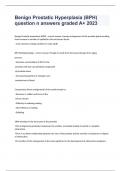
-
Benign Prostatic Hyperplasia (BPH) question n answers graded A+ 2023
- Exam (elaborations) • 9 pages • 2023
- Available in package deal
-
- $9.99
- + learn more
Benign Prostatic Hyperplasia (BPH) question n answers graded A+ 2023 Benign Prostatic Hyperplasia (BPH) - correct answer a benign enlargement of the prostate gland resulting from increase in number of epithelial cells and stream tissue. -most common urologic problem in male adults BPH Pathophysiology - correct answer Though to result from hormonal changes from aging process: -Excessive accumulation of DHT in the prostate cells that can stimulate overgrowth of prostate tissue -...
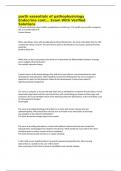
-
porth essentials of pathophysiology chapt 39 Exam Questions With Verified Answers Graded A+
- Exam (elaborations) • 11 pages • 2024
-
- $10.99
- + learn more
porth essentials of pathophysiology chapt 39 Exam Questions With Verified Answers Circumcision is avoided in infants who have hypospadias so that the foreskin can be used for surgical repair. True A 60-year-old man comes to the clinic and has been found to have a history of type 2 diabetes mellitus and cardiovascular disease. The manifestations of these diseases will warrant the nurse to assess the patient for which of the following problems? Erectile dysfunction The nurse is asses...
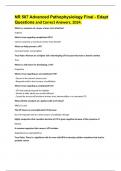
-
NR 507 Advanced Pathophysiology Final - Edapt Questions and Correct Answers, 2024.
- Exam (elaborations) • 10 pages • 2024
- Available in package deal
-
- $13.00
- + learn more
NR 507 Advanced Pathophysiology Final - Edapt Questions and Correct Answers, 2024. What is a symptom of a lower urinary tract infection? Urgency What is true regarding complicated UTIs? Can be caused by a structural urinary tract disorder What can help prevent a UTI? Increased water consumption True/False: Women are at higher risk of developing UTI because they have a shorter urethra True What is a risk factor for developing a UTI? Pregnancy What is true regarding an uncomplicated UTI...
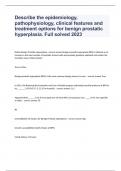
-
Describe the epidemiology, pathophysiology, clinical features and treatment options for benign prostatic hyperplasia. Full solved 2023
- Exam (elaborations) • 11 pages • 2023
- Available in package deal
-
- $12.99
- + learn more
Describe the epidemiology, pathophysiology, clinical features and treatment options for benign prostatic hyperplasia. Full solved 2023Define Benign Prostatic Hyperplasia - correct answer Benign prostatic hyperplasia (BPH) is defined as an increase in the total number of prostatic stromal cells and prostatic glandular epithelial cells within the transition zone of the prostate. True or false: Benign prostatic hyperplasia (BPH) is the most common benign tumour in men. - correct answer True ...
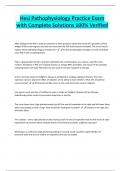
-
Hesi Pathophysiology Practice Exam with Complete Solutions 100% Verified
- Exam (elaborations) • 10 pages • 2024
- Available in package deal
-
- $10.99
- + learn more
Hesi Pathophysiology Practice Exam with Complete Solutions 100% Verified After talking w/ the HCP, a male pt continues to have questions about the results of a prostatic surface antigen (PSA) screening test and asks the nurse how the PSA levels become elevated. The nurse should explain which pathophysiological mechanism? As the prostate gland enlarges, its cells contribute more PSA in the circulating blood PSA is a glycoprotein found in prostatic epithelial cells, and elevations are use...

Did you know that on average a seller on Stuvia earns $82 per month selling study resources? Hmm, hint, hint. Discover all about earning on Stuvia


